
Carl Fredrik Fallén was a Swedish botanist and entomologist.
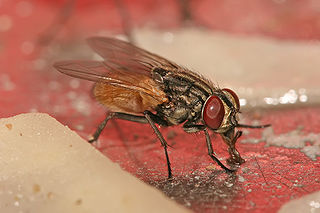
Muscidae are a family of flies found in the superfamily Muscoidea.

Eristalis is a large genus of hoverflies, family Syrphidae, in the order Diptera. Several species are known as drone flies because they bear a resemblance to honeybee drones.

The Eulophidae is a large family of hymenopteran insects, with over 4,300 described species in some 300 genera. The family includes the genus Elasmus, which used to be treated as a separate family, "Elasmidae", and is now treated as a subfamily of Eulophidae. These minute insects are challenging to study, as they deteriorate rapidly after death unless extreme care is taken, making identification of most museum specimens difficult. The larvae of very few species feed on plants, but the majority are primary parasitoids on a huge range of arthropods at all stages of development. They are exceptional in that they are one of two hymenopteran families with some species that are known to parasitize thrips. Eulophids are found throughout the world in virtually all habitats.

Musca is a genus of flies. It includes Musca domestica, as well as Musca autumnalis. It is part of the family Muscidae.

The housefly is a fly of the suborder Cyclorrhapha. It possibly originated in the Middle East, and spread around the world as a commensal of humans. It is the most common fly species found in houses. Adults are gray to black, with four dark, longitudinal lines on the thorax, slightly hairy bodies, and a single pair of membranous wings. They have red eyes, set farther apart in the slightly larger female.
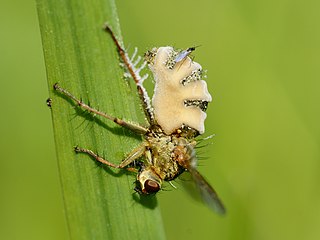
Entomophthora muscae is a species of pathogenic fungus in the order Entomophthorales which causes a fatal disease in flies. It can cause epizootic outbreaks of disease in houseflies and has been investigated as a potential biological control agent.
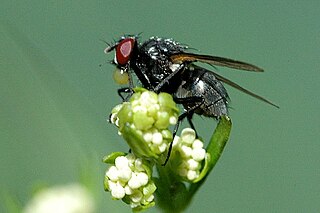
Hydrotaea is a genus of insects in the housefly family, Muscidae. They occur in most regions of the world but are more populous in warmer climates. They are often found on feces in summer months, and are therefore generally found in close proximity to livestock. Among the 130 known species in this genus, one of the most commonly recognized is the dump fly.
Baryscapus is a genus of hymenopteran insects of the family Eulophidae. Species in this genus are endoparasitic, meaning they develop within the body of another insect, with insect hosts being as varied as Hemiptera, Neuroptera, Coleoptera, Lepidoptera, Diptera, or other Hymenoptera.

Leptocybe invasa, the blue gum chalcid wasp or eucalyptus gall wasp, is a chalcid wasp which is the only species in the monotypic genus Leptocybe in the subfamily Tetrastichinae, of the family Eulophidae. It is a gall wasp which causes the formation of galls on a number of species of Eucalyptus, it was described in 2004 after galls were found in river red gums in the Mediterranean and Middle East and has since been found to be a widespread species where its host trees are planted. It is indigenous to Australia.

Omphale is a genus of hymenopteran insects of the family Eulophidae. It has cosmopolitan distribution.
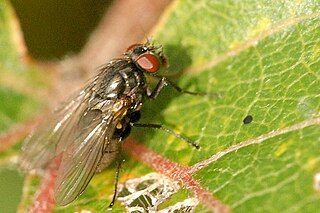
Fannia armata is a fly species in the Fanniidae family. This species is smaller and more slender than the house fly, Musca domestica, and is similar in appearance to the lesser house fly, Fannia canicularis. It is found in the Palearctic. For identification see
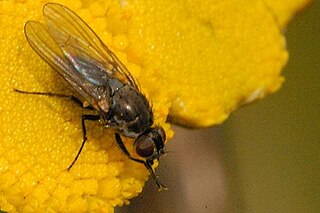
Fannia lepida is a fly species in the Fanniidae family. This species is smaller and more slender than the house fly, Musca domestica, and is similar in appearance to the lesser house fly, Fannia canicularis. It is found in the Palearctic. For identification see

Fannia sociella is a fly species in the Fanniidae family. This species is smaller and more slender than the house fly, Musca domestica, and is similar in appearance to the lesser house fly, Fannia canicularis. It is found in the Palearctic. For identification see
Macrocheles muscaedomesticae is a species of mite in the family Macrochelidae. It has a cosmopolitan distribution.
In the 10th edition of Systema Naturae, Carl Linnaeus classified the arthropods, including insects, arachnids and crustaceans, among his class "Insecta". Insects with simply two wings were brought together under the name Diptera.
Hytrosaviridae is a family of double-stranded DNA viruses that infect insects. The name is derived from Hytrosa, sigla from the Greek Hypertrophia for 'hypertrophy' and 'sialoadenitis' for 'salivary gland inflammation.'
Muscidifurax uniraptor is a species of wasp in the family Pteromalidae. The species does not currently have a common name. M. uniraptor is a pupal parasitoid of synanthropic filth-breeding Diptera and is a natural enemy of the housefly Musca domestica and the stable fly Stomoxys calcitrans.
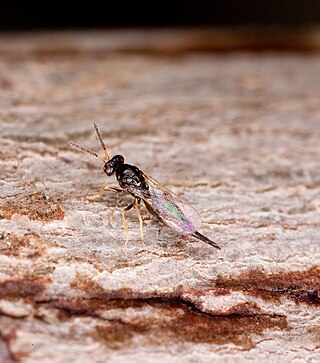
Tetrastichinae is a subfamily of the chalcid wasp family Eulophidae. It is one of the largest subfamilies of the Eulophidae containing over 100 genera and nearly 3,000 species. The species of the family Tetrastichinae are found in almost any type of terrestrial habitat and have a worldwide distribution, except Antarctica. They show a varied biology and hosts for Tetrastichinae wasps have been identified from over 100 different insect families, across 10 different orders and they have also been recorded as being parasitoids on nematodes, mites and spiders' eggs. Some species are even phytophagous, while others are inquilines and yet others are gall formers.

Hydrotaea aenescens, known generally as black dump fly, is a species in the family Muscidae. Other common names include the black garbage fly and dump fly. It is found in Europe. Larvae of this species are predators of Musca domestica. The adults are known vectors of human botfly eggs.













